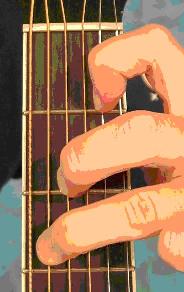All beginner guitarists struggle with switching between chords at first, thats part of the learning curve. Here are some tips on the subject, but make sure you watch our video lesson on how to change between guitar chords, where I will show you the correct technique of learning chord changes. Watch my hands closely to see the correct method.

The main reason beginner guitarists experience difficulties when switching between chords quickly doesn't really have that much to do with their fingers. The main problem is that beginners haven't learned to visualize which chord they're about to play, and which fingers they'll need to move. This means that once they get to where they would need to change chords, they start thinking about which finger goes where, which means that there will be a lag between the chord changes.
Here is a step-by-step exercise routine to help:
- Pick 2 guitar chords you can already play, since the exercise will have you moving between these chords. The exercise is great for your trouble chords as well.
- Strum the first chord 4 times, and keeping the rhythm of your strumming going, quickly move to the next chord, and play that chord 4 times.
Was there a lag between the chord change? If your answer is yes, let's drill in an see how we can fix it. Try this, but don't strum this time:
- Put your fingers back into position and fret the 1st chord.
- Now change to the next chord as quick as you can, and just watch your fingers as they move.
- When your fingers come off of the fretboard, you'll probably have a couple of them hovering while you try to decide where each finger need to be placed. The reason this happens is because you haven't visualized where each finger needs to go before the chord change.
- Now, hold down the 1st chord again, then without actually changing to the 2nd chord, visualize the next chord shape. Visualize where each finger will go, one finger after the other, and how to do so most efficiently. By this, I mean don't lift any fingers unnecessarily, don't separate your fingers if you don't need to, and so on.
- Once you got the next chord shape in your mind, switch. Do this as much as you need to, before your fingers start moving fluently between the chords. The key is to visualize.
- Remember to switch chords efficiently with the least amount of motion as possible. Don't bring your fingers far off the fretboard, since its a waist of time.
Change between these chords for 3 minutes every day, chances are you'll have them going perfectly in 2-3 days. Remember to visualize, don't take you fingers apart or far off the fretboard unnecessarily, and just keep at it. It may seem difficult now, but believe me, all superstar guitarists started out just like you 🙂

Been playing (use that term loosely) for about 6 months and have since day one been almost unable to play the C chord properly. It sounds off or crap etc.. Even if I stop playing and try to play a C chord I notice my fingers touching two strings sometimes…. frustrating. Have tried playing around with more vertical fingers on frets, moving palm closer etc… May need to go to a different music teacher. Have started noticing even G chord is acting up now with fingers touching more than one string… Gosh…
Tuck your left elbow in next to your side, Place your left thumb a little above center between the first and second fret. Relax! Place your fingers right next to the frets (touching the frets is preferable but not over the frets) Try to make your fingers have a nice arch) Relax, Put pressure on all three strings at the same time! Now strum!
Wow, 50 cords seems like a lot to learn, I think I’d have overload and it would ultimately slow me down. Inch by inch life’s a cinch.
Hi,
Hope you are doing great…!
Firstly, I really thank & appreciate you from my bottom of heart for E-help/E-support.
Secondly, I am striving to play chords but not able to play frequently with the beats(1st case) also facing less energy with the ring finger(2nd case) compare to other fingers while I try to play chords. So, please guide me how to improve these two cases.
Would be highly obliged for the prompt suggestion/guiding.
Thanks in anticipation
TKR
Hi there,
This is common with beginners, here’s what you need to do:
1. Start doing finger exercises across the fretboard, and use a metronome while doing this. This will strengthen your fingers, improve their coordination, and improve you sense of rhythm as well.
2. You probably heard this a lot, but the more you practice, the better you get. It doesn’t happen overnight though, you need to play every day, and that’s how you see constant improvement.
3. Play songs based around chords, to get your fingers used to forming those chord shapes and changing in between them.
Here are a bunch of songs that use chords: https://www.theguitarlesson.com/lesson-type/chords/
And here are some strumming songs as well:
https://www.theguitarlesson.com/lesson-type/strumming/
It’s still really hard to get used to. Just like ProFuzz said: practice a lot!
I remember the way I learned to switch quickly the chords from one to another!
1) Take a peace of paper and write down about 50 absolutely different chords – without any order
2) The first day it took me 5 minutes to play through all of them
3) Practice, practice, practice
4) Try to make the playing time as short as possible (about 30 seconds)
Here it is!